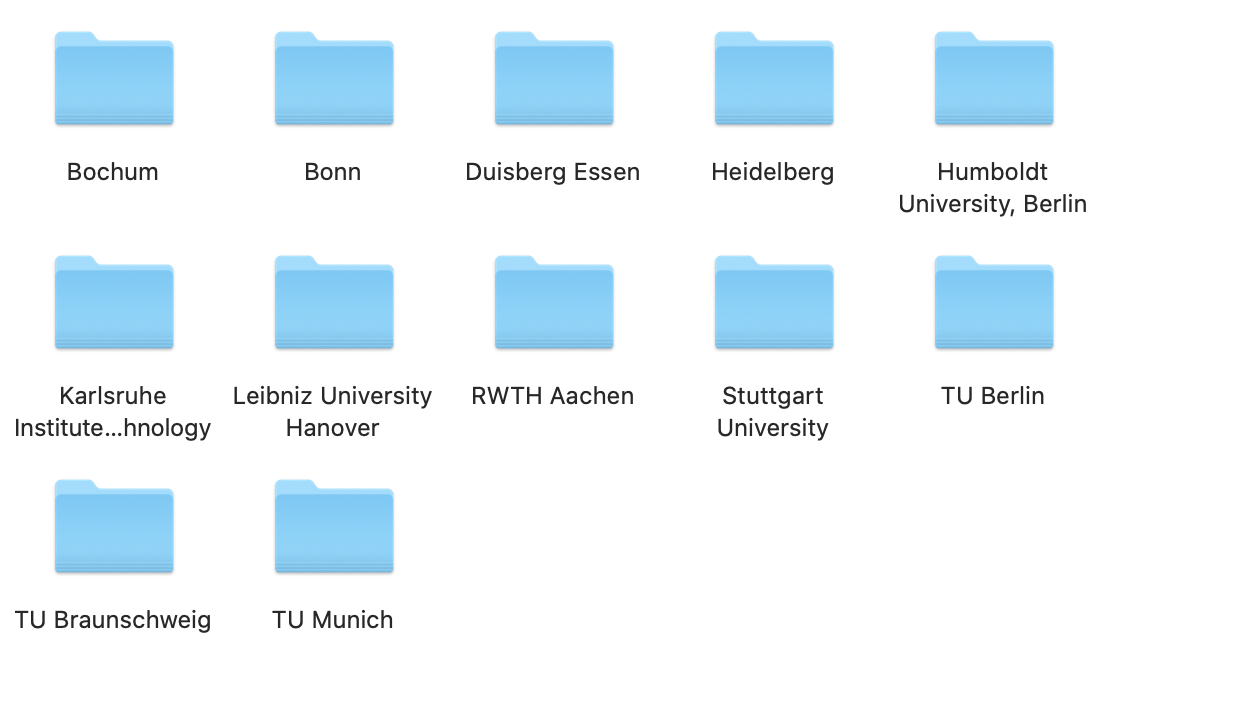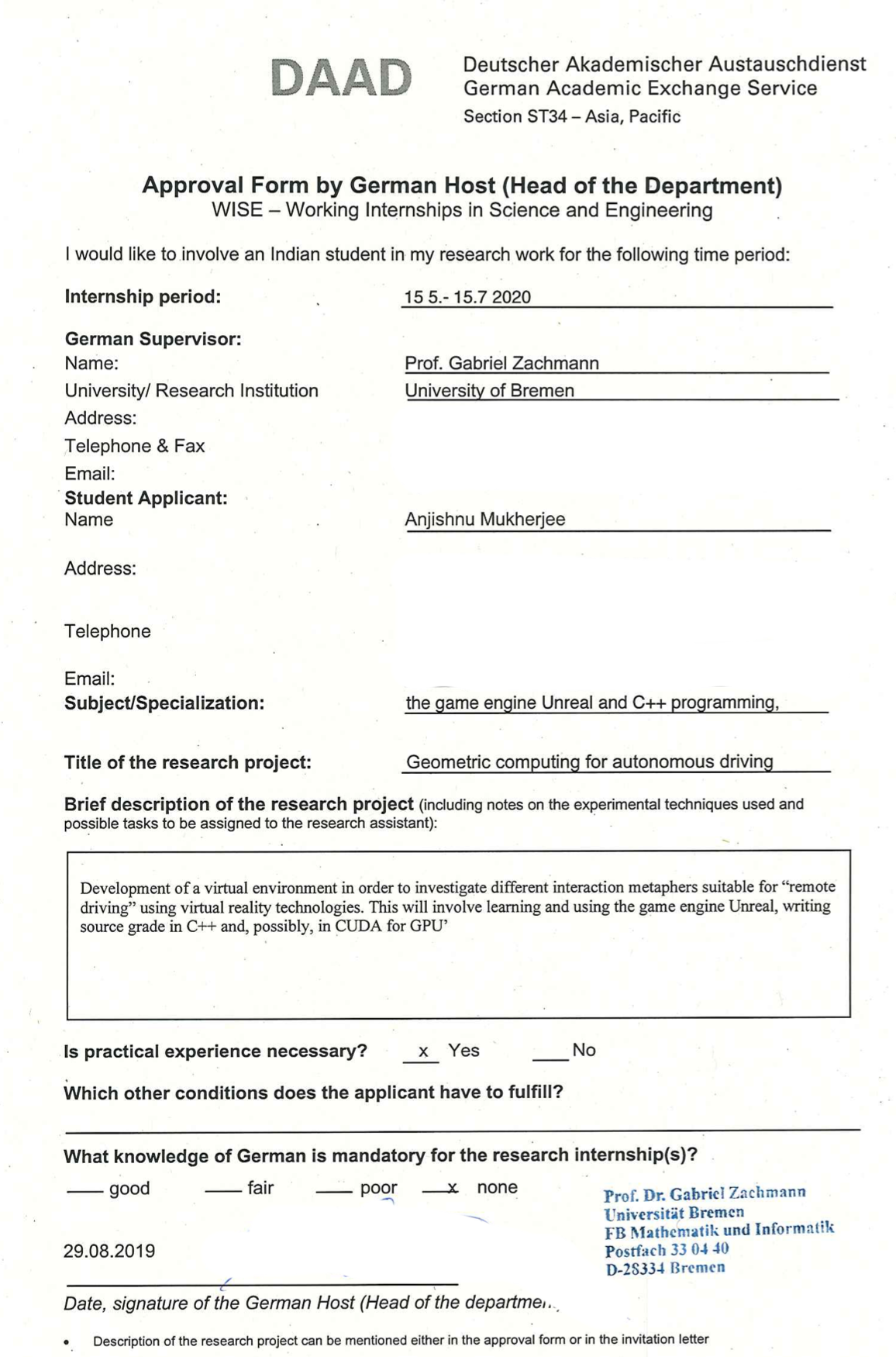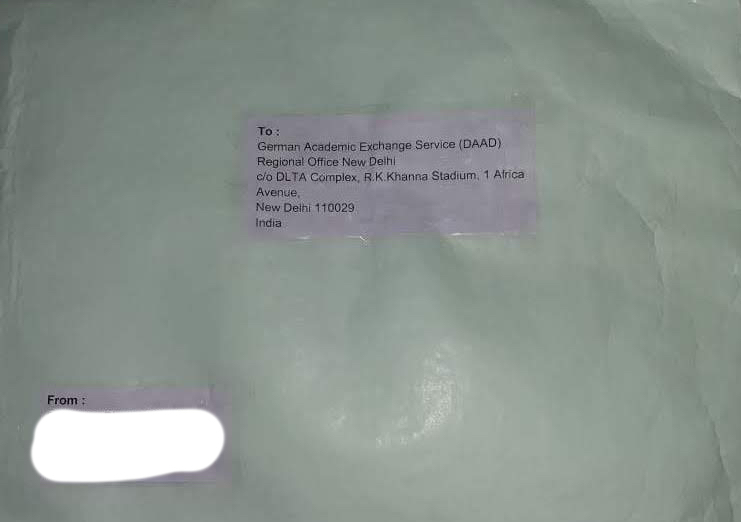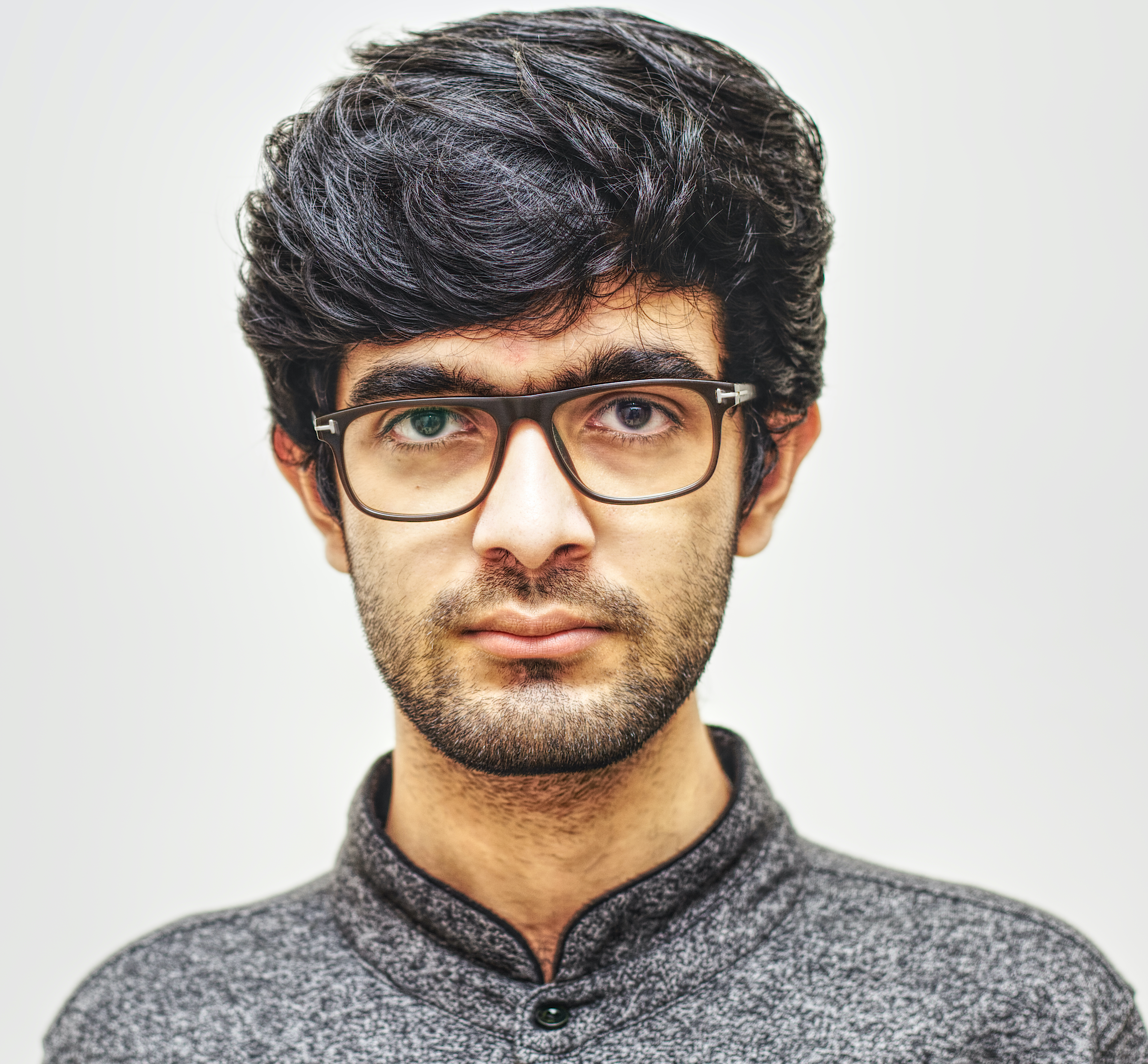Everything about the DAAD WISE scholarship

A lot of people have hit me up on different platforms asking about this. So, here, it is, once and for all. DAAD WISE demystified.
Students (from India) apply for summer internships in universities abroad. It is a pretty common phenomenon and there isn’t any reason to deliberate too much about it. Why do they do it? Well, because there are many good labs working on top class stuff even outside of India and working there on some project is not only a massive learning experience, but also looks damn good on any CV when someone wants to apply for jobs or higher studies later on. Now, the thing is, most students are not rich enough to pay for the travel and living costs for these internships out of their own pockets. Here is where scholarships come in to play. Notice that the internship and the scholarship are 2 different entities. In this blog, I will be very quickly over the process of getting the internship first, and then I will detail the application process for the scholarship. Also, I will restrict myself to Germany only. There are multiple other excellent options for scholarships, like MITACS, SN BOSE, RISS CMU,Charpak to name a few. But, I didn’t apply to any of those, and can’t really elaborate!
Get the Internship first
“How do I go about finding professors ?”
This takes some time. I spent nearly 2 entire weeks doing just this.
Here is how I would do it. I would try to look first at which universities I would like to go to. Then for each of those univs, I would look through all the professors in the relevant labs and see who is doing work that I like the most. To do this, I would look up the professor on Google Scholar or some other similar platform and then maybe download and read atleast the abstracts of 2-3 of their latest papers. Usually their latest papers would be related to whatever they are working on currently. And sometimes, they might even mention the topics explicitly on their website. Then, I would try to connect the dots of the abstract with work that I have done before, and find a best fit. Obviously, you can apply to multiple places, so don’t just choose one, choose multiple fits and then rank them as per your preference order and best-fit order.
How many profs did you mail, how many responses did you get, how long did it take ?
This varies with luck mostly. Some people write 100’s of emails and receive back no response.
I wrote to 13 different professors. I receieved positive responses from 2, negative responses from 4, and no responses from the rest. For those emails which I got responses for, it usually was either within the same day or within the same week. For those that I didn’t get a response for, I even sent 1 follow-up email after a week, and still did not receive any response. So, I took it as a rejection and decided not to bother them further. I sent all my 13 emails on the same day. Some people prefer to send batches of emails across many days. Remember, if you get multiple positive responses and then ghost everyone except the one you like, that doesn’t look good. So, be nice and leave a short email to the people explaining that you respect their time and how you feel that pursuing a different option migt be more beneficial for you at the moment. Good relationships with people can go a long way!

These are the 12 other ones apart from University of Bremen.
“What do I write in the email ?”
When your pre-final (this means 3rd year for a 4 year engineering course) year starts, you are expected to know an area of interest. Something that spikes your imagination, keeps you happy! For me, this was Computer Vision and Computer Graphics, something at the junction of those two. Around August-September, your task would be to look up different labs, professors and institutes working on cool projects in your area of interest and then email them. Emails have to be smart and to the point. Have a look at the example below first.

Don't copy this word for word, please? 😏
Write out the text for your emails first, very clearly. You need to go through the lab’s current work / projects and recent papers to do so. Choose a project / topic and mention it explicitly. Explain how your experiences are relevant for this particular thing. Don’t add your resume directly. Instead, add a link to your online CV (make a simple webpage with the same contents as your CV). The reason for this, when you attach a document with an email, some mailing systems used by universities view it as spam. To avoid any chance of getting rejected due to this stupid reason, just use a website. You can build one using Google Sites or Wix, or if you have some free time (or if you already know some basic web stuff), you can even build a straight-forward website in a day or two.
The email should be very focused. It should discuss about the project you want to apply for, and how your relevant experiences can help you in doing well in it. Usually profs also have a list of active current projects available on the website. It’s better to choose one from there and mention that in the email if possible, better than just blindly “applying”.
Also, the email should have a slightly urgent tone in the sense that you need to ask the professor to reply back as soon as possible, otherwise you will be running into issues with deadlines. People usually send these emails around August-September period. And the scholarship application deadline is usually around end of October.
Send the email on a Monday morning 1 hr before 10 AM German time (look up the exact time of the city you are applying to), so that the email is fresh on the top of the stack of stuff the professor might go through after coming to the office after the weekend. A good idea usually is also to include the professor’s assitant by cc’ing the mail, because, we all agree that professors are busy people and can forget stuff sometimes. Some labs might not have dedicated assistants, PhD students or PostDocs are equivalent for this purpose in such cases. Wait a week for a response. If you don’t get back any response, do not be afraid to send a follow-up email in the same thread.
If you don’t get back any response after 2-3 weeks, it is probably better to look at other options. Don’t feel dejected. This isn’t the end of the world. Look for other internship programs worldwide or even in India (IITs are still the best you can get in India when it comes to academics).
If you receive a positive response, the professor might ask to schedule for a short interview via video meet. Be prepared to answer basic questions from your domain of study and also related to the domain of the work being conducted in the lab. Once the initial conversation is over, you need to ask the professor for the following documents.
- Invitation Letter

Personal details blurred out. 🥺
- Completed Approval Form

Personal details blurred out. 😌
Usually the professor’s assistant would fill these out. In case there are mistakes or errors in any part of the document, make sure you politely ask them to change it. Also, do note that if the German proficiency is marked as required in the above document, you might be needed to provide a document of proof for the level of proficiency you have in the language. So, better, try to avoid having such requirements in the first place, if you don’t know the language well enough.
Once you have these 2 documents, you need to get a NOC from your home institute back in India.

Personal details blurred out. 😪
I assume you already have a CV / Resume by this point in your life at the ready. You would need that for the next step, keep it handy.
You also need to procure transcripts from your university. What are transcripts and how are they different from your regular academic records that you receive after every semester? Well, consider it like this, when you are applying for the scholarship, you need a compilation of all the results across the previous semesters as one single document called the transcript.
And you need a Letter of Reference from a professor at your home university. Easy enough to get this, provided someone knows you! The professor will give you the LOR in a sealed envelope, do not open it. You just have to pack it in with a couple of other stuff and send it to DAAD.
Once you have all the five documents mentioned above ready, move into step 2.
Apply for the scholarship
You need to go the DAAD WISE website and fill in an application form. They tell you exactly what you need to fill and where you need to fill it. So, just follow the instructions and you should be good to go. Once you are done completing the application, you would get an application summary, a single document, that will be around 20 pages long, composed of some basic info that you filled up when applying, and some other documents. See the image below.

Too many documents, ayyyyy! 👀
Apart from the research proposal, the other things I have already discussed above. Now, coming to this particular document, you need to write using proper scientific terms a brief description about the project. Consider it as writing a 2 page summary of the project, but completely technical and written using LaTeX. Writing it in LaTeX is optional. You can obviously use Google Docs or Microsoft Word or anything else. LaTeX just looks so much better to me, and there are hundreds of free templates available on Overleaf. Try to include a timeline for all the stuff that you plan to do as part of the project. You might ask your advisor or a PhD student at his lab to help you out with this, though the extent of the help will be pretty limited in most cases.
Now, once you are at this stage around October, all you need to do is upload everything to the DAAD portal under Personal Funding > Application and Funding overview. (Again, the DAAD WISE website has steps detailing exactly how to go about this step)

To give you an idea of what you are looking for 💯
Also, note that, some of these documents only open using Adobe Acrobat, and you are supposed to fill it in using only that. It is free software for the purposes you might need it here for, so in case you don’t use it regularly, download it, now!
You also need to send a physical copy of the application summary and the LOR to the DAAD office in Delhi via post.

Takes a couple of days via speed post 👌🏻
Now, you just have to chill till atleast January next year. Unofficially they let you know by then if you have been selected or not, so that you can move on with other options. Official Letter of Award and other documents come by in early March or end February.
Usually around 130-150 people get selected every year. Though the exact number isn’t really made publicly available. So, it is competitive. If you don’t get in, don’t feel bad. You can still attend your internship if you manage to find alternate sources of funding (including self-funding).
The DAAD WISE Applications Facebook Group is a great resource before the application deadline and also once results are announced. Be active there to catch whiff of the latest news about who got selected that year and other helpful information. The documents section of this page has some very useful stuff, that you can take a look at to get an idea about what to fill in the different forms on the portal.
That’s all folks! I exhausted my 2 cents about this process, and I couldn’t possibly go in any more depth even if I tried. For future reference, whenever anyone asks me about DAAD, I am gonna refer them to this post for clarifications!
Bye 👋🏻👋🏻
